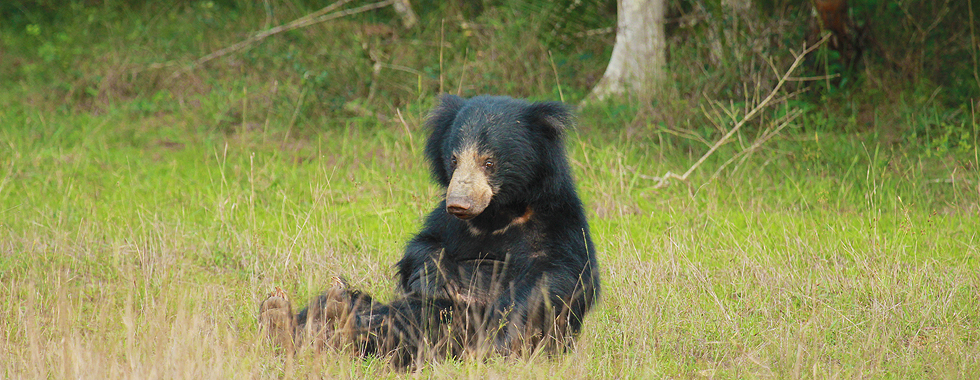Baring bear facts
View(s):A challenging study by two researchers will soon reveal the little known lifestyle of the Wilpattu sloth bear. Kumudini Hettiarachchi reports
They roughed out in the wilds day and night, keeping their eyes glued on the thickets to get a glimpse of these elusive creatures, peered at them through powerful cameras and captured them on camera-traps that they fixed in the jungles.
All the insect-bitten nights and the long days with only scrap meals, sometimes just gulping down water, have paid off.
Some of the ‘secrets’ of the sloth bear, an iconic large mammal of this country, are now out in the open, while the vacuum in the knowledge about them is slowly but surely being filled.
For, two researchers are now privy to the ‘lifestyle’ of the not-much-researched sloth bear ensconced in the still-pristine Wilpattu National Park close to Anuradhapura.
The duo who undertook this arduous challenge are researchers Ranil Nanayakkara and Nilantha Vishvanath of Biodiversity Education and Research (BEAR).

Ranil Nanayakkara
The sloth bear is listed as ‘Endangered’ by the Ministry of Environment in the National Red List for Sri Lanka. Although it is the ‘third’ in Sri Lanka’s ‘Big Three’, with the others being the elephant and the leopard, not much research has been carried out on this majestic animal in recent times, except for two studies conducted by Eisenberg and Lockhart in 1972 and Rathnayake in 2000-2001.
The quest for knowledge on the sloth bear has not been without its inherent dangers including a close-encounter with an enraged elephant, the head-butt of which has left a dent on the jeep, a reminder to Ranil and Nilantha of the narrow shave they had.
The sloth bear project has been undertaken by BEAR with the unstinting support of the Department of Wildlife Conservation and the assistance of CIC Holdings PLC, with the Business & Biodiversity Platform of the Chamber of Commerce acting as the coordinator. Well-known mammal expert, Prof. Devaka Weerakoon is providing the technical support for the project.
Where do the sloth bears in Wilpattu prefer to live, what are their favoured foods, what are their amorous traits and what of their offspring are some of the questions the researchers have been able to gather information on, while some questions still remain unanswered.
Camera-traps placed in crucial locations in the Maradanmaduwa area and the 10km line-transect for the silent-device census, as well as the study of pug-marks and scat (droppings) have been the tools used in this study.
 There have been 39 direct visual encounters including during night drives with Ranil and Nilantha seeing with their own eyes 26 males, six females, three cubs and four “unidentified” bears. These were in addition to the other information collected through the other techniques which have all enabled the duo to come up with a rough sketch of the lifestyle of the sloth bear within the park.
There have been 39 direct visual encounters including during night drives with Ranil and Nilantha seeing with their own eyes 26 males, six females, three cubs and four “unidentified” bears. These were in addition to the other information collected through the other techniques which have all enabled the duo to come up with a rough sketch of the lifestyle of the sloth bear within the park.
“Initially, we thought the preferred habitat of sloth bears was rock outcrops and caves, but there being not much granite at Wilpattu, they are using decaying trees and hollows they excavate in the earth as their dens,” says Ranil, adding that although they are frequently seen near the unique villus, the animals amble back to forested areas. “They like the primeval forest with its ancient trees.”
Although an earlier study had indicated that the home range of this creature is about 1.34 sq.km, the Sunday Times learns that in Wilpattu it is wider, with the males sometimes having an overlap of their territories.
Ranil’s excitement is tangible when he describes some of the ‘subjects’ of their scrutiny. One she-bear with two cubs is “beautiful” with its glossy coat, while another with two cubs is “scraggy”.
There is a broad smile when he talks of a third female which had one cub. Many had been the debates among Nilantha, the tracker and himself because she had no fur at the end of her tail which resembled a sausage which could lead to a misconception about her gender. The cub at her side had effectively ended the dispute.
Explaining that the identification of the individual sloth bears came from scars, marks and the shape, size and length of pug-marks, Ranil recalls how inquisitive one male was. As much as their human observers were watching the sloth bears, this curious male had taken to ‘inspecting’ them closely. One night, on hearing a “chara-chara” noise, when Ranil flashed the spotlight, they had found the male staring at them questioningly.
Earlier notions of when sloth bears mate have also been overturned. Whereas it had been thought that they mate from November to January and July-August, the love-making peak of Wilpattu’s sloth bears is May, June and July. “It’s a noisy affair with lots of grunting lasting the whole night,” laughs Ranil who had seen them indulging in their affections on trees.
One handsome he-bear with a sleek coat had not at all been inhibited when the jeep Ranil and Nilantha were in, encountered him and his lady-friend in the dead of night. While the she-bear was shy and coy, moving into a thicket, the he-bear had strutted up to about five metres from the jeep.
Regrettably though the exact gestation period is yet unknown. The cubs, like pups, are born blind, and the mothers are seen with them around April, May, June and July, says Ranil.
What seems to tickle the sloth bear’s palate most, meanwhile, according to Ranil, is not palu, but weera, dang and third in line, palu. The scat also indicates a termite diet, but an analysis would be needed to find out which species of termites they consider a delicacy.
Scat has also revealed some interesting differences between the males and the females – while the males poo in lumps to mark their territory, the females drop their dung on the move, Ranil says, adding that Boraluwala, a waterhole near Maradanmaduwa is a male haunt, proven by the scats found in plenty there.
As they collate their findings and pass a fine-tooth comb through the information to analyse them, the sloth bears will not be left a forgotten entity after only one research.
Phase II of the sloth-bear project is collaring these creatures to get definitive answers on their home range. Radio collars put on sloth bears will help confirm the findings of Phase I with regard to their den sites as well.
For all those involved in the research, the escalating human-bear conflict is a serious worry. “We hope our research will help in the conservation of the sloth bear,” adds Ranil.
Radio collaring on the cardsHappy over the basic data collated under Phase I of the sloth bear project, CIC Managing Director and Chief Executive Officer Samantha Ranatunga assures that they are hoping to launch the radio-collaring under Phase II early next year.
 Samantha Ranatunga “There is a lot more to do,” said wildlife aficionado Mr. Ranatunga who is not only an active member of the Business & Biodiversity Platform but is also funding the sloth bear project. He is past Chairman of the Platform’s Advisory Committee. The Platform is a joint initiative of the Ceylon Chamber of Commerce, the International Union for the Conservation of Nature (IUCN) and Dilmah Conservation. Referring to the sloth bear, Mr. Ranatunga drew a parallel between this “misunderstood animal” and the “misunderstood industry” that he represents. The sloth bear is inquisitive and the knee-jerk reaction from humans results in this creature getting killed. It seems to be the same with the chemical industry.
A year’s findings open to public ‘The Sri Lankan Sloth Bear: Recent findings from Wilpattu’ will bring before the public the ‘yield’ of a year’s project, on Wednesday (October 29) from 4.30 to 6.30 p.m. at the National Science Foundation auditorium, 47/5, Maitland Place, Colombo 7. The co-founder of Biodiversity Education and Research (BEAR), Ranil Nanayakkara will make the presentation on ‘Working towards estimating the sloth bear population densities in the Wilpattu National Park – Interesting facts and findings from the field’. The goal of the project’s Phase I lasting from July 2913 to June 2014 was to map and evaluate the population density and composition of sloth bears in Wilpattu, the largest National Park, and identify their habitat needs and preferences. Getting down to the technicalities, Ranil says that the sloth bear is a member of the family Ursidae found in the lowlands of Sri Lanka, India, Bangladesh and Nepal. The two recognized sub-species are Melursus ursinus and Melursus ursinus inornatus. The techniques used to get a census were spotlight census, track census and camera trapping, says Ranil. While scat samples have also been collected to be analyzed for their seasonal diet and possible DNA, the project initiators are hoping that all the information gained at Wilpattu could then be applied islandwide in conservation strategies for the sloth bear. |


